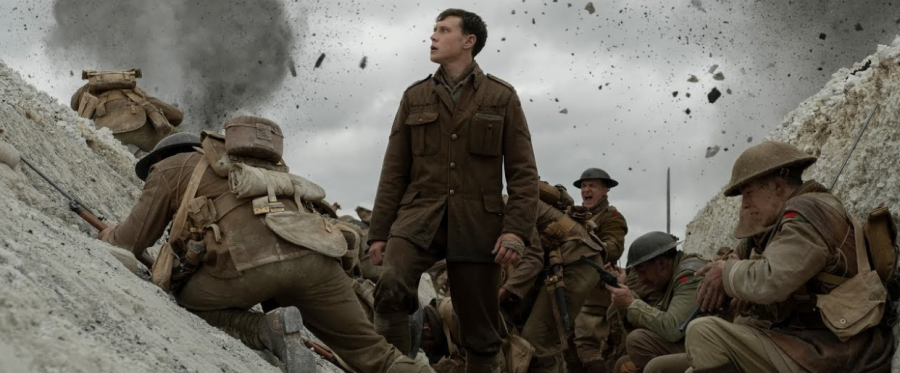1917: World War One-Shot
This is how I feel walking into a class twenty minutes late during an exam.
February 9, 2020
The year is 1917. The trenches are muddy, the German helmets are pointy, Russia is having a revolution and Woodrow Wilson is really hopeful about this whole “League of Nations” thing.
Our story opens on a pair of British soldiers who are assigned the job of hand-delivering a message to a commander elsewhere on the Western front. This commander and over 1,500 soldiers are walking into a trap, and if our two protagonists Schofield and Blake fail to deliver the message, then the losses will be catastrophic.
Well, not so catastrophic that they couldn’t entrust the mission to two random guys with barely any motivation as it is.
“1917”‘s claim to fame is that the entire film consists of one long take. From the moment the movie starts, we stay with these two men the entire time, never cutting away or transitioning to another battlefield. Whether you like it or not, you stay in the trenches. This puts us directly into the shoes of the characters. Blake is a patriotic young Brit who accepts the mission and recognizes what’s at stake, but that doesn’t mean he is some badass. He’s just a normal guy trying to do his bit for his king and country.
Schofield hates the war and risking his life as much as I hate parking at CCSU, but that doesn’t mean he’s going to up and leave Blake.
The movie starts off quiet and almost serene as we are brought into the trenches, never idling away or waiting for the plot to progress. But when things ramp up in intensity, there’s a palpable sense of danger. We barely even see any Germans in the entire film, but the knowledge that they’re there persists throughout.
We get to see Schofield and Blake silently clearing out empty trenches, watching each others backs. If this were an American film, it probably would’ve included a scene of the duo explaining how they used to play football in college or some flag-waving nonsense. “1917” relies on its cinematography to explain the relationships of it’s characters.
“1917” has remarkably tight pacing. The entire experience is almost exactly two hours long and a lot of ground is covered as we travel alongside our characters.
We start off in a peaceful meadow, travel into a brown trench with neatly kept sandbag walls and soldiers sleeping along the sides, then the scene seamlessly shifts into the trenches on the front lines. They are littered with black mud, bombed-out walls and disheveled soldiers, not knowing when a sniper might peek out and put them down. When the journey properly begins, we’re subjected to the vast, terrifying no man’s land. Corpses are strewn in various states of decay, some seeming to have been there for years, each telling a story about how a group of young men met a tragic fate. Good stuff. Fun for the whole family.
Alright I can’t do much from this point without getting into spoilers, so consider this a recommendation. If you even remotely like war films or unique methods of filming, then “1917” will not disappoint.
Instead I offer a story about my movie experience, courtesy of AMC.
In a relatively quiet moment following an intense standoff with a German soldier, Schofield hides away in the basement of a ruined house and comes across a French woman caring for a baby that isn’t hers. They cannot understand each other, but the baby stops crying with Schofield, who begins telling him a story. It’s a beautiful scene. We’re not expected to believe this is supposed to be romantic for Schofield and woman he can’t even speak to, but it reminds us of the humanity that anyone can have, even as they are surrounded by people who want to kill them. As Schofield told his story the screen went black. At first I thought it was some kind of artsy representation of the baby drifting off to sleep, but the screen stayed off and the characters continued speaking.
Good old AMC Plainville lost connection to all of the projectors in the entire theater. The audience sat in silence for about 15 minutes before the scene restarted and we saw everything we missed. I don’t even know how it happened. I would love to imagine the uproar this would have if it happened during the climax of some Marvel film that people have convinced themselves is quality viewing.
On the bright side, the audience got a nifty bathroom break sandwiched neatly in the last quarter of the film.
Go watch “1917.” Consider it homework if you have a class about World War One. It’s utterly unique and wonderfully crafted. The perfect way to start your year.







